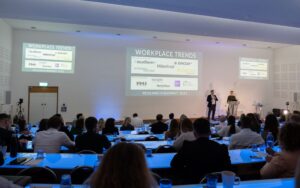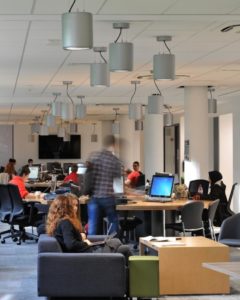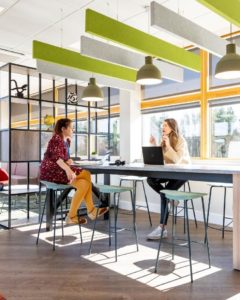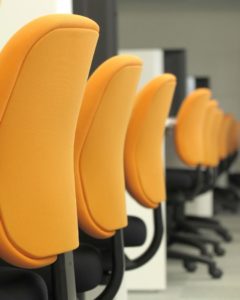Here are my key takeaways (in no particular order of importance) with insights from some of the speakers.
Glasgow and Edinburgh are lagging way behind the UK when it comes to the return to the office.
Working predominantly with organisations in Scotland, this was one of the biggest takeaways for me.
Lorna Landells / Darren Yates (Remit Consulting) presented the results from a 2-year, UK-wide study of c.150 offices, reporting on the average occupancy as measured by access control systems. They were assisted in their data collection by some of the large property management organisations (C&W, Savills etc.).
This study reported that office occupancy was sitting at about 30-40% (ONS data reports that WFH numbers have plateaued at about 35-40%) across the UK as a whole, but with Glasgow and Edinburgh sitting at about half that figure. This low figure is impacted by the local lockdown restrictions in Scotland being tougher but also by the higher-than-average percentage of public sector jobs in Glasgow.
Across the 2-years of the study, the number of visitors to the buildings has picked up and is indicative of people getting out and about.
The presenters proposed that higher occupancy was connected to amenities, and this might influence developers to favour mixed use projects. Kasia Maynard (Gensler Research Institute) gave a very detailed presentation later in the day on the theme of hybrid working and how it impacts our cities, with a specific focus on workplace amenities. (More details here – Gensler UK Workplace Survey 2023)
A good team will be enhanced by a good space.
It’s not rocket science that most workplace issues (and solutions) are people issues (and solutions). Think of investing in people before investing in space – poor teams won’t suddenly start thriving in great space.
Rachel Casanova / Sophie Schuller (Cushman & Wakefield) We hire people based on ‘human capital’ but are interested in the outcomes that come from innovation (‘social capital’). People being in the same physical space resulted in a growth in trust with hierarchy becoming less important. With WFH, managers needed to connect us to networks. Work got done during lockdown (‘to do’ lists were crossed off – human capital wasn’t affected) but the social capital aspects suffered. But human and social capital need to be balanced – optimised for organisational effectiveness and the employee experience – with a mix of formal and informal communication and interaction.
Expanding your network, branching out into new teams, means new norms and that can feel uncomfortable – it might be good for the organisation but goes against perceived employee experience. With regard to high-performing workplaces, poor managers / teams will not benefit from these spaces.
Bertie van Wyk (Miller Knoll) reported on the latest data (February 2023) from the Future Forum surveys (https://futureforum.com/) that he has been reporting on over the past few years. These surveys gather input from thousands of knowledge workers across US, UK, Germany etc. Having seen a BCO seminar given by Bertie in Glasgow recently, it was not new ground for us, but his passion always makes it worthwhile listening. On the theme of engagement (something I am interested in), Bertie implored us to not just leave it to HR, but also to involve Marketing in formulating a communication strategy. Of interest was the reported figure for people being in the office 5 days / week – 35% – which from the perspective of the Scottish market seemed really high (and having just been on a Leesman webinar, is higher than they reported).
Muriel Altunaga (The Flow) gave a presentation on the needs of teams and how these differ from the needs of the individual (though a lot of them are the same). Being able to book spaces together so learning by osmosis takes place is important as is space for socialising. Ultimately there needs to be a purpose for bringing teams together.
‘Alone Together’ – we need to create nooks for people in workplaces.
Privacy and lack of disturbance have become increasingly important (again) as buildings are getting busier.
Harriet Shortt (University of the West of England & Bibo) got the biggest ‘cheer’ of the day with the use of some good old Anglo-Saxon when discussing the experience of working in a flagship building where transparency was good in theory but not in practice. The short-form title of her talk was ‘making dens at work’ and reported on a photography-based project where students were asked to submit images and text to describe their lived experiences within the new Business School building.
This year-long project fed into the traditional post occupancy evaluation. Where transparency and visibility were promoted by the design, the experience of staff and students was more of surveillance and permanent availability. In order to achieve some secrecy, furniture was being reconfigured, paper being put on glass partitions – people were shaping their own places.
Security didn’t mean being isolated, these ‘dens’ could be in with others, it was a conscious decision to be ‘alone together’.
4-day week pilots have been an overwhelming success.
If hybrid working is here to stay, is the introduction of the 4-day week the next step and will it get us closer to Keynes’s prediction of a 15-hour work week?
Kyle Lewis (Autonomy Research Limited) reported findings on the 6-month (June-Dec ’22) UK 4-day week pilot study. The results were overwhelmingly positive, involving 61 companies / c.2900 staff (though it transpired during the questioning that one care organisation made up 1/3 of the total headcount).
The stipulation for participating in the study was that organisations had to report a meaningful reduction in hours with no loss in pay.
- 89% of organisations went for a 5th day stoppage (and yes, it was a Friday).
- There was no reported negative impact to business performance (revenue actually increased by 1.4% over the course of the study).
- 71% of staff reported a reduction in burnout levels (though 22% did report an increase)
- 40% reported a reduction in sleep difficulty, and anxiety levels fell substantially.
- In terms of quantity of work during reduced hours, 1/3 reported an increase in pressure (but with no increase in stress levels – they had seemingly accepted pressure would increase), 1/3 reported a decrease in pressure.
- 91% of businesses said they would continue with the 4-day week pilot (with 18 making it permanent) with the reasons for lack of success in pilots boiling down to buy-in not happening at all levels.
Of note was the difference in adoption models. In the US / UK it was more likely to be a company-level adoption, whereas in Europe interest was driven by trade unions or progressive political parties.
Why the 4-day week? It was more likely to be related to recruitment and retention of staff. If the outputs are the same with 1 fewer day worked, what is being cut out? A reduction in meeting culture and streamlined decision-making were reported as the key indicators of efficiencies.
Building regulations focus on physical accessibility – “can we design our way into more mental wellbeing?”
Neurodiversity was a central topic in several presentations – to quote a phrase from a previous WT meeting – “design for the range not the average”.
Lene Becker (Laika Rumdesign) addressed mental wellbeing in the workplace, sharing the figure that depression / anxiety results in 12 billion work days lost / year.
· Workplace loneliness can affect physical health (reducing life expectancy by the same amount as smoking 15 cigarettes / day) but is reported as being less of an issue for older workers (or perhaps just they are less willing to mention it).
- Millennials will constitute 75% of the workforce in 2025, but 92% have experienced a mental health condition – both important figures. Millennials expect certain things (inclusion, access to management, transparency). Are organisations geared up for this?
- The last topic was neurodiversity (affecting up to 1 in 7 people in the UK) and Lene highlighted that building regulations are primarily concerned with accessibility for those with mobility issues (e.g., using wheelchairs).
- Only 8% of the 14.1m disabled people in the UK use a wheelchair – that means 92% of disabled people are potentially experiencing a built environment that doesn’t work for them.
An environment needs to offer variety and choice and support psychological safety also (a trustful environment where people feel comfortable admitting mistakes and sharing doubts).
David O’Coimin (Nook) comes from a product design and furniture background and reinforced the idea that no one size fits all, we are not all the same and with particular reference to dyslexia, we need to see it as a strength (discovery, invention, creativity being traits to be capitalised) as different minds are needed to solve problems. Google are getting involved in inclusive design with the neu project – starting with events and hospitality spaces but they will eventually be looking at the design of workplaces, as stated, with a key focus on inclusion. “Demonstrable inclusion can boost engagement, value and outcomes”. Inclusive design means we all win.
This was an ambitious day – the meeting started one hour earlier than normal and unlike other Workplace Trends meetings, didn’t have the pre-lunchtime light-weight presentation. It was a full-on day. As with every conference / meeting, there were some highs, some lows, but in general it was an interesting experience to be back in the room (which I am glad to say warmed up as the day went on).





